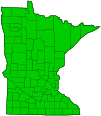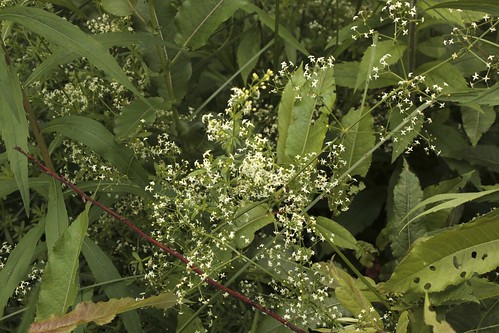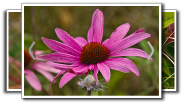northern bedstraw
(Galium boreale)
Conservation • Wetland • Description • Habitat • Ecology • Use • Distribution • Taxonomy
Description |
Northern bedstraw is a 6″ to 40″ tall, erect, perennial forb that rises on numerous stems from a creeping rhizome. The stems are ascending, erect, or reclining on the ground. They are slender, 4-angled, hollow, and many branched. They are usually hairless except for a short beard of hairs just below the nodes. Sometimes they are rough with minute, stiff hairs. They do not have hooked hairs. The leaves are stalkless and in whorls of 4. They are linear lance-shaped, ⅝″ to 1¾″long, and up to 3 ⁄16″ wide. There are often two leaves opposite each other within a whorl that are significantly longer than the other two. The leaf blades have 3 veins, 1 prominent midvein and 2 less prominent but plainly visible lateral veins, running from the base to the tip. They are rounded at the tip. The upper surface is green and hairless. The lower surface is light green and sparsely hairy. The margins are untoothed and have a fringe of hairs. The leaves do not have hooked hairs. The inflorescence is a showy, branched, about 4″ long and wide, round-topped cluster (cyme) of numerous stalked flowers at the end of the stem. Each division of the cyme is subtended by a pair of elliptic bracts. The flowers are ⅛″ to ¼″ wide. There are 4 white to cream-colored petals fused at the base into a short tube then separated into 4 short lobes with pointed tips. There are 4 stamens with white filaments and yellowish-brown anthers, and 2 styles. There are 2 carpels at the base of the flower. The carpels are light green, hairy, and joined together. They do not have hooked hairs. The fruit is a green, sometimes hairy, ball-like, 1-seeded capsule, joined in pairs. It does not have hooked hairs. |
Height |
6″ to 40″ |
Flower Color |
White to cream |
Similar Species |
Northern bedstraw often has two leaves opposite each other within a whorl that are significantly longer than the other two. Other bedstraws have leaves within a whorl that are identical in size. Licorice bedstraw (Galium circaezans var. hypomalacum) has much wider leaves and 3 prominent parallel veins. |
Habitat |
Dry to wet. Woods, forests, prairies, meadows, fields. |
Ecology |
Flowering |
June to July |
Pests and Diseases |
|
Use |
|
Distribution |
||
|
Sources |
|
| 3/7/2025 | ||
Nativity |
||
Native |
||
Occurrence |
||
Common and widespread |
||
Taxonomy |
|
Kingdom |
|
Division |
Tracheophyta (Vascular Plants) |
Subdivision |
Spermatophytina (Seed Plants) |
Class |
|
Order |
Gentianales (Gentians, Dogbanes, Madders, and Allies) |
Family |
Rubiaceae (madder) |
Subfamily |
Rubioideae |
Tribe |
Rubieae |
Genus |
Galium (bedstraws) |
Subordinate Taxa |
|
|
|
Synonyms |
|
Galium boreale var. hyssopifolium Galium boreale var. intermedium Galium boreale var. linearifolium Galium boreale var. scabrum Galium boreale ssp. septentrionale Galium boreale var. typicum Galium hyssopifolium Galium septentrionale Galium strictum |
|
Common Names |
|
northern bedstraw |
|
Glossary
Bract
Modified leaf at the base of a flower stalk, flower cluster, or inflorescence.
Carpel
The female reproductive organ of a flower, consisting of an ovary, styles, and stigmas.
Cyme
A branched, flat-topped or convex flower cluster in which the terminal flower opens first and the outermost flowers open last.
Rhizome
A horizontal, usually underground stem. It serves as a reproductive structure, producing roots below and shoots above at the nodes.
Visitor Photos |
||
Share your photo of this plant. |
||
This button not working for you? |
||
Dan W. Andree |
||
Almost other world like looking creature... that is what came to mind observing this poison ivy sawfly from certain angles. I found it really interesting and it had a nice color pattern to it. I could get close to it moving slowly and quietly and it just went about its business I believe feeding on something on those little flowers. It wasn’t real big or anything maybe an inch and a quarter or so in length though some online sites state they are 11mm. which is almost half an inch. This one was at least one inch or a little more in length. |
 |
|
I thought it was some type of wasp at first until later on. At Frenchman’s Bluff SNA where I seen it on June 20, 2024 there is a lot of poison ivy growing in areas and that is what the larvae/poison ivy caterpillars feed on. Poison Ivy Sawflies do not have any stinger and this creature though strange looking wasn’t aggressive and almost seemed like a gentle creature. It was the first and only time I seen one. It may look a little strange, but anything whose larvae feed on poison ivy plants gets my approval. And it is harmless to people. I thought it was a strange looking creature at first, but found it to be harmless, very beneficial to the area I seen it at and a real educational learning experience. Cool creature. |
||
MinnesotaSeasons.com Photos |
||
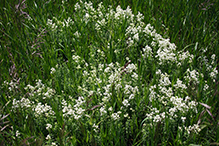 |
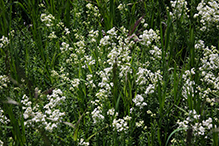 |
|
Habitat |
Habitat |
|
 |
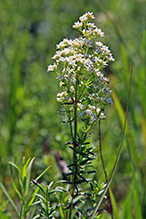 |
|
Plant |
Plant |
|
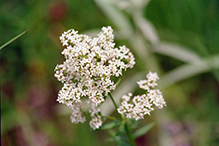 |
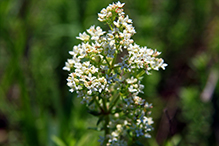 |
|
Inflorescence |
Inflorescence |
|
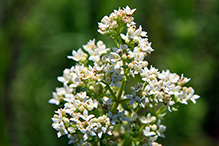 |
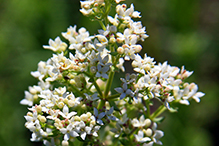 |
|
Inflorescence |
Flowers |

Visitor Videos |
||
Share your video of this plant. |
||
This button not working for you? |
||
|
Other Videos |
||
|

Visitor Sightings |
||
Report a sighting of this plant. |
||
This button not working for you? |
||
Dan W. Andree |
Location: Frenchman’s Bluff SNA Almost other world like looking creature... that is what came to mind observing this poison ivy sawfly from certain angles. I found it really interesting and it had a nice color pattern to it. I could get close to it moving slowly and quietly and it just went about its business I believe feeding on something on those little flowers. It wasn’t real big or anything maybe an inch and a quarter or so in length though some online sites state they are 11mm. which is almost half an inch. This one was at least one inch or a little more in length. |
 |
I thought it was some type of wasp at first until later on. At Frenchman’s Bluff SNA where I seen it on June 20, 2024 there is a lot of poison ivy growing in areas and that is what the larvae/poison ivy caterpillars feed on. Poison Ivy Sawflies do not have any stinger and this creature though strange looking wasn’t aggressive and almost seemed like a gentle creature. It was the first and only time I seen one. It may look a little strange, but anything whose larvae feed on poison ivy plants gets my approval. And it is harmless to people. I thought it was a strange looking creature at first, but found it to be harmless, very beneficial to the area I seen it at and a real educational learning experience. Cool creature. |
||
MinnesotaSeasons.com Sightings |
||
Badoura Jack Pine Woodland SNA Bertram Chain of Lakes Regional Park Carpenter St. Croix Valley Nature Center Charles A. Lindbergh State Park Felton Prairie SNA, Bicentennial Unit Hardscrabble Woods / MG Tusler Sanctuary Itasca Wilderness Sanctuary SNA Margherita Preserve-Audubon Prairie Mound Spring Prairie SNA, North Unit Nerstrand Big Woods State Park Northern Tallgrass Prairie NWR, Pavia Unit Northern Tallgrass Prairie NWR, Rengstorf Unit Northern Tallgrass Prairie NWR, Touch the Sky Prairie Unit P.N. and G.M. Nelson Wildlife Sanctuary Prairie Creek WMA, Koester Prairie Unit Sand Prairie Wildlife Management and Environmental Education Area Two Rivers Aspen Prairie Parkland SNA |
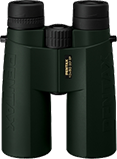
|
Created: 6/13/2006 Last Updated: © MinnesotaSeasons.com. All rights reserved. |
